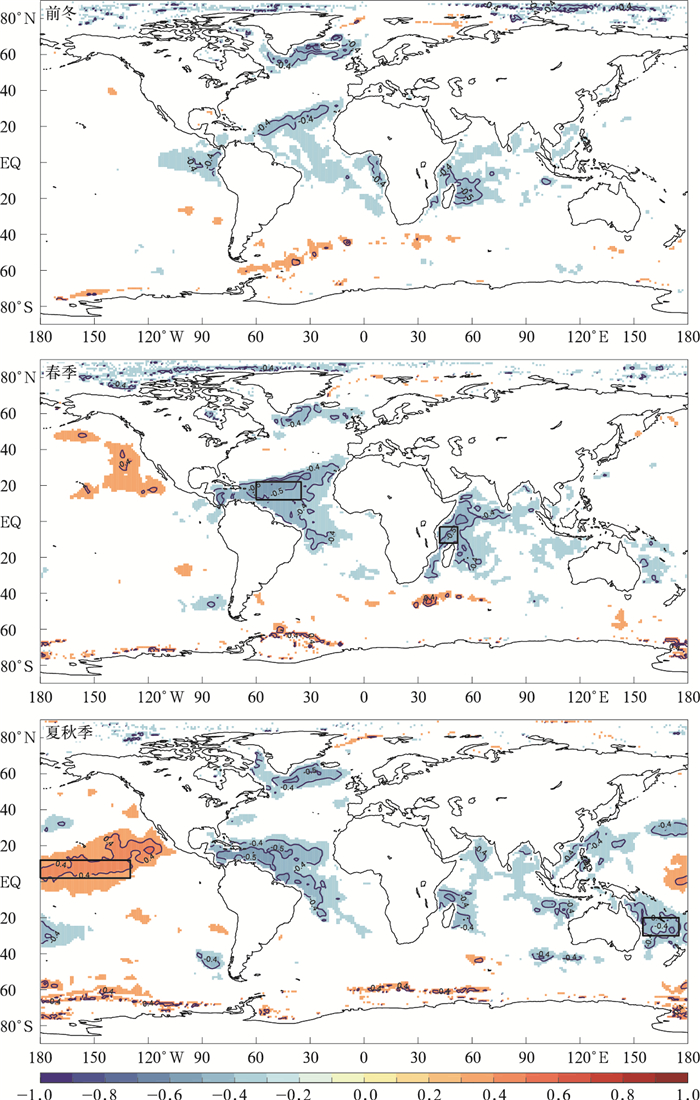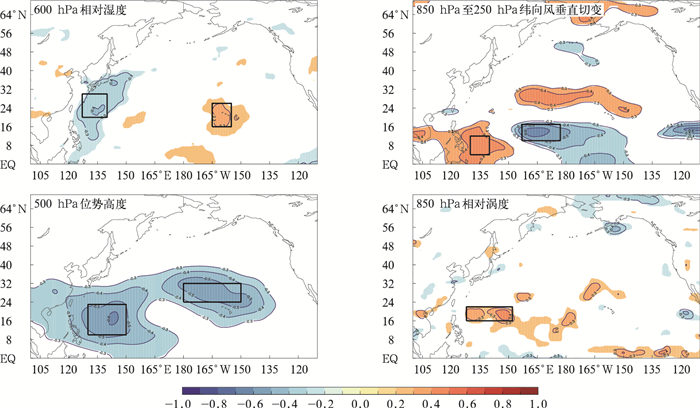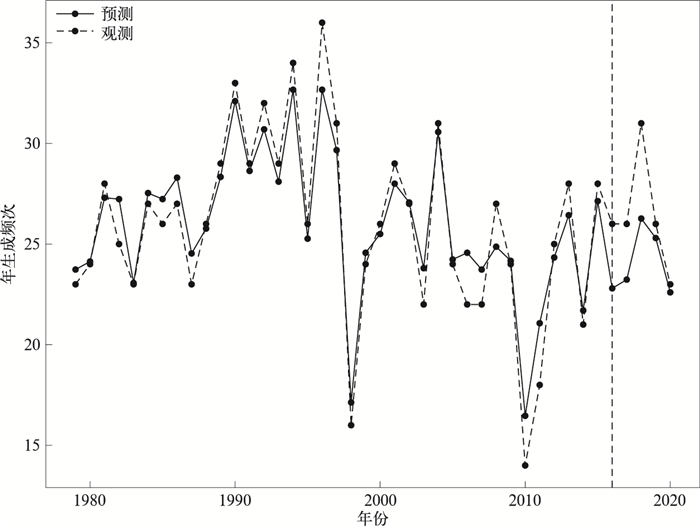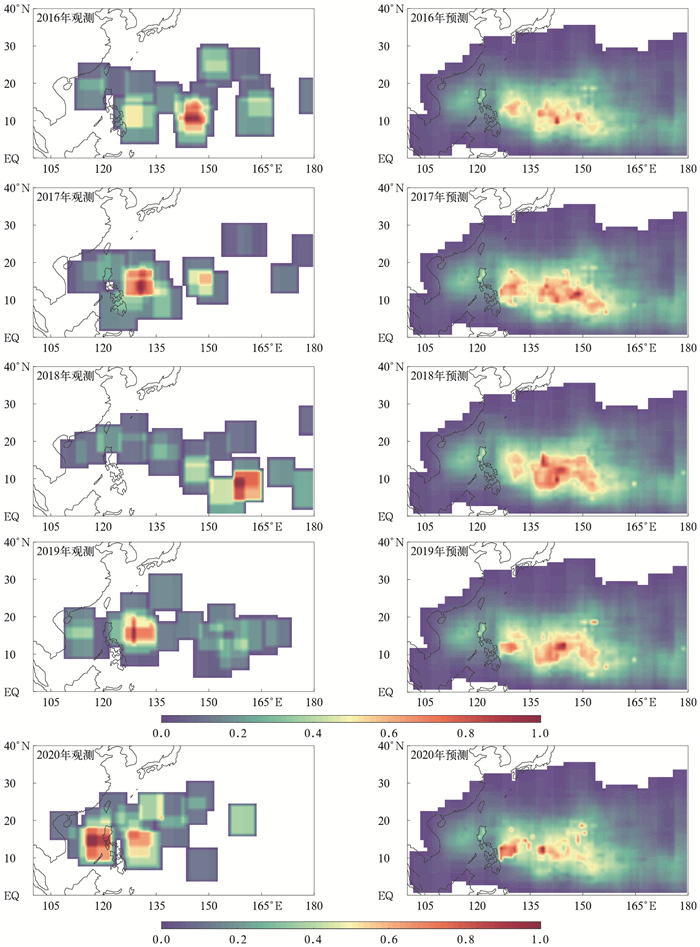An Objective Prediction Model for Tropical Cyclone Genesis in the Northwest Pacific
-
摘要: 该文提出一种西北太平洋热带气旋年生成活动的客观预测模型。研究大尺度环境因子对西北太平洋热带气旋年生成频次的作用,使用最小角回归算法对初始14个预测因子进行选择和降维,将资料集分为训练集(1979—2015年)和验证集(2016—2020年),建立随机森林回归模型预测热带气旋年生成频次。分析环境因子对西北太平洋热带气旋生成位置的作用,使用逐步回归算法筛选影响显著的预测因子,建立局部泊松回归模型预测热带气旋生成空间位置的概率。结果表明:随机森林回归模型可以预测西北热带气旋频次的主要变化和趋势,揭示环境因子对西北太平洋热带气旋年生成频次的影响。局部泊松回归模型对于气旋生成位置概率有一定预测能力。利用随机森林回归模型和局部泊松回归模型模拟1979—2020年西北太平洋热带气旋生成,结果与观测基本一致,可见模型可为热带气旋危险性分析提供参考。Abstract: At present, the maximum predictable time of tropical cyclone using numerical model is limited to 2 weeks. Statistical forecasting methods have substantial advantages in mining the potential value of massive meteorological and oceanographic observations, surpassing the limit of numerical forecast, and providing a new way to solve the bottlenecks of tropical cyclone forecasts. A novel statistical prediction scheme is proposed for tropical cyclone annual frequency and genesis location in the Northwest Pacific. The effect of large-scale meteorological factors including sea surface temperature, the geopotential height, the humidity, the vorticity, the wind shear, the Nio3.4 index, the QBO index and the SO index on the annual frequency of tropical cyclone in Northwest Pacific are considered. Correlations between the annual frequency of tropical cyclone and the large-scale environmental variables are analyzed and 14 highly correlated predictors are selected to predict tropical cyclone frequency. The least absolute shrinkage and selection operator method is used to select 8 factors from 14 initial predictors. Then, a prediction model based on random forest is established using training samples (1979-2015) for calibration and testing samples (2016-2020) for validation. In addition, the impact of environmental conditions including the vorticity, the wind shear, the humidity, the potential intensity, the sea surface temperature anomaly and the Nio3.4 index on the formation location of tropical cyclone is also investigated. The stepwise regression algorithm is used to choose a set of independent predictive variables by an automatic procedure. The local Poisson regression is performed on training datasets using count data inside data circles whose size is determined by the method of likelihood cross validation maximation. The seasonality of tropical cyclone genesis location is added to Poisson model. Results show that the random forest model presents a major variation and trend of tropical cyclone annual frequency though there are some deviations from the fitted data. The rank importance of influence indicates the primary effect of sea surface temperature and secondary effect of atmospheric variables on tropical cyclone frequency, which further reveals the applicability of the random forest model. The local Poisson regression model predicts where the tropical cyclone is most likely to occur. This model performs well when tropical cyclone occurs in the region of the Philippine and has some deviation in some months when tropical cyclone occurs in the region of the South China Sea. This model has good performance in predicting tropical cyclone genesis location but is weak in predicting abnormal situations. Finally, these two models are used to simulate tropical cyclone genesis activity in 1979-2020. The distribution of simulated tropical cyclone genesis points is consistent with the observations. This new prediction scheme can provide support for tropical cyclone risk analysis.
-
图 1 西北太平洋热带气旋年生成频次与海表温度相关分析
(填色,仅显示达到0.05显著性水平的相关系数)(方框表示预测因子的位置)
Fig. 1 Correlations between the annual frequency of tropical cyclone in the Northwestern Pacific and sea surface temperature
(the shaded, only correlations passing the test of 0.05 level are given) (the box denotes the predictor location)
图 2 西北太平洋热带气旋年生成频次与夏秋季大尺度环境因子相关分析
(填色,仅显示达到0.05显著性水平的相关系数)(方框表示预测因子的位置)
Fig. 2 Correlations between the annual frequency of tropical cyclone in the Northwestern Pacific and the large-scale environmental factors from Jun to Nov
(the shaded, only correlations passing the test of 0.05 level are given)(the box denotes the predictor location)
表 1 预测因子
Table 1 Selected predictors
预测因子 相关系数 描述 X1 -0.53 12°~22°N, 35°~60°W区域平均春季海温异常 X2 -0.50 3°~12°S, 45°~52°E区域平均春季海温异常 X3 -0.48 20°~30°S, 155°~175°E区域平均夏秋季海温异常 X4 0.45 30°~40°N,130°~140°W区域平均夏秋季海表温度异常 X5 -0.57 10°~23°N,130°~150°E区域平均夏秋季500 hPa高度场异常 X6 -0.56 24°~32°N,180°~210°W区域平均夏秋季500 hPa高度场异常 X7 -0.61 20°~30°N,127°~140°E区域平均夏秋季600 hPa相对湿度异常 X8 0.57 16°~26°N,155°~165°W区域平均夏秋季600 hPa相对湿度异常 X9 0.63 16°~22°N,128°~152°E区域平均春季850 hPa相对涡度异常 X10 -0.62 4°~12°N,130°~140°E区域平均夏秋季850 hPa与250 hPa纬向风垂直切变 X11 0.45 10°~17°N,157°E~177°W区域平均夏秋季850 hPa与250 hPa纬向风垂直切变 X12 -0.09 春季Nio3.4海温 X13 0.09 夏秋季平流层准两年振荡指数 X14 0.06 前年夏秋季南方涛动指数 表 2 预测因子重要性排序
Table 2 Importance ranking of predictors
因子 重要性 X2 0.247933 X10 0.174951 X7 0.170453 X5 0.120027 X9 0.113977 X13 0.067993 X11 0.061185 X4 0.043481 表 3 最优半径
Table 3 Optimized scale
月份 最优半径/km 1 1200 2 1500 3 1400 4 1300 5 1200 6 1100 7 900 8 800 9 800 10 900 11 1100 12 1200 -
[1] 李欣, 张璐.北上台风强降水形成机制及微物理特征.应用气象学报, 2022, 33(1):29-42. doi: 10.11898/1001-7313.20220103Li X, Zhang L. Formation mechanism and microphysics characteristics of heavy rainfall caused by northward-moving typhoons. J Appl Meteor Sci, 2022, 33(1): 29-42. doi: 10.11898/1001-7313.20220103 [2] 井喜, 贺文彬, 毕旭, 等. 远距离台风影响陕北突发性暴雨成因分析. 应用气象学报, 2005, 16(5): 655-662. doi: 10.3969/j.issn.1001-7313.2005.05.012Jing X, He W B, Bi X, et al. Analysis of the abrupt rainstorm in north Shaanxi in relation to typhoon far away. J Appl Meteor Sci, 2005, 16(5): 655-662. doi: 10.3969/j.issn.1001-7313.2005.05.012 [3] 杨舒楠, 端义宏. 台风温比亚(1818)降水及环境场极端性分析. 应用气象学报, 2020, 31(3): 290-302. doi: 10.11898/1001-7313.20200304Yang S N, Duan Y H. Extremity analysis on the precipitation and environmental field of Typhoon Rumbia in 2018. J Appl Meteor Sci, 2020, 31(3): 290-302. doi: 10.11898/1001-7313.20200304 [4] 何立富, 陈双, 郭云谦. 台风利奇马(1909)极端强降雨观测特征及成因. 应用气象学报, 2020, 31(5): 513-526. doi: 10.11898/1001-7313.20200501He L F, Chen S, Guo Y Q. Observation characteristics and synoptic mechanisms of Typhoon Lekima extreme rainfall in 2019. J Appl Meteor Sci, 2020, 31(5): 513-526. doi: 10.11898/1001-7313.20200501 [5] Noy I. The socio-economics of cyclones. Nature Clim Change, 2016, 6: 343-345. doi: 10.1038/nclimate2975 [6] Zhang Q, Wu L, Liu Q. Tropical cyclone damages in China 1983-2006. Bull Amer Meteor Soc, 2009, 90(4): 489-496. doi: 10.1175/2008BAMS2631.1 [7] 张永恒, 范广洲, 马清云, 等. 浙江省台风灾害影响评估模型. 应用气象学报, 2009, 20(6): 772-776. doi: 10.3969/j.issn.1001-7313.2009.06.017Zhang Y H, Fan G Z, Ma Q Y, et al. The evaluation model of typhoon disaster influence on Zhejiang Province. J Appl Meteor Sci, 2009, 20(6): 772-776. doi: 10.3969/j.issn.1001-7313.2009.06.017 [8] 矫梅燕, 龚建东, 周兵, 等. 天气预报的业务技术进展. 应用气象学报, 2006, 17(5): 594-601. doi: 10.3969/j.issn.1001-7313.2006.05.009Jiao M Y, Gong J D, Zhou B, et al. An overview of the development of weather forecasting. J Appl Meteor Sci, 2006, 17(5): 594-601. doi: 10.3969/j.issn.1001-7313.2006.05.009 [9] 陈联寿. 热带气旋研究和业务预报技术的发展. 应用气象学报, 2006, 17(6): 672-681. doi: 10.3969/j.issn.1001-7313.2006.06.005Chen L S. The evolution on research and operational forecasting techniques of tropical cyclones. J Appl Meteor Sci, 2006, 17(6): 672-681. doi: 10.3969/j.issn.1001-7313.2006.06.005 [10] 王诗文. 国家气象中心台风数值模式的改进及其应用试验. 应用气象学报, 1999, 10(3): 347-353. doi: 10.3969/j.issn.1001-7313.1999.03.013Wang S W. Advances on typhoon numerical model of NMC and applied experiments. J Appl Meteor Sci, 1999, 10(3): 347-353. doi: 10.3969/j.issn.1001-7313.1999.03.013 [11] 丑纪范. 天气和气候的可预报性. 气象科技进展, 2011, 1(2): 11-14. https://www.cnki.com.cn/Article/CJFDTOTAL-QXKZ201102007.htmChou J F. Predictability of weather and climate. Adv Meteor Sci Tech, 2011, 1(2): 11-14. https://www.cnki.com.cn/Article/CJFDTOTAL-QXKZ201102007.htm [12] Li M, Zhang S Q, Wu L X, et al. An examination of the predictability of tropical cyclone genesis in high-resolution coupled models with dynamically downscaled coupled data assimilation initialization. Adv Atmos Sci, 2020, 37(9): 939-950. doi: 10.1007/s00376-020-9220-9 [13] 陶祖钰, 赵翠光, 陈敏. 谈谈统计预报的必要性. 气象科技进展, 2016, 6(1): 6-13. https://www.cnki.com.cn/Article/CJFDTOTAL-QXKZ201601006.htmTao Z Y, Zhao C G, Chen M. The necessity of statistical forecasts. Adv Meteor Sci Tech, 2016, 6(1): 6-13. https://www.cnki.com.cn/Article/CJFDTOTAL-QXKZ201601006.htm [14] 孙健, 曹卓, 李恒, 等. 人工智能技术在数值天气预报中的应用. 应用气象学报, 2021, 32(1): 1-11. doi: 10.11898/1001-7313.20210101Sun J, Cao Z, Li Heng, et al. Application of artificial intelligence technology to numerical weather prediction. J Appl Meteor Sci, 2021, 32(1): 1-11. doi: 10.11898/1001-7313.20210101 [15] Chen R, Zhang W M, Wang X. Machine learning in tropical cyclone forecast modeling: A review. Atmosphere, 2020, 11(7): 676-704. doi: 10.3390/atmos11070676 [16] Wang Z, Zhao J, Huang H, et al. A review on the application of machine learning methods in tropical cyclone forecasting. Front Earth Sci, 2022. DOI: 10:10.3389/feart.2022.902596. [17] Vickery P J, Skerlj P F, Steckley A C, et al. Hurricane wind field model for use in hurricane simulations. J Struct Eng, 2000, 126(10): 1203-1221. doi: 10.1061/(ASCE)0733-9445(2000)126:10(1203) [18] Rumpf J, Weindl H, Höppe P, et al. Stochastic modeling of tropical cyclone tracks. Math Method Oper Res, 2007, 66: 475-490. doi: 10.1007/s00186-007-0168-7 [19] Rumpf J, Weindl H, Höppe P, et al. Tropical cyclone hazard assessment using model-based track simulation. Nat Hazards, 2009, 48: 383-398. doi: 10.1007/s11069-008-9268-9 [20] Emanuel K, Ravela S, Vivant E, et al. A statistical deterministic approach to hurricane risk assessment. Bull Amer Meteor Soc, 2006, 87(3): 299-314. doi: 10.1175/BAMS-87-3-299 [21] 方伟华, 石先武. 面向灾害风险评估的热带气旋路径及强度随机模拟综述. 地球科学进展, 2012, 27(8): 866-875. https://www.cnki.com.cn/Article/CJFDTOTAL-DXJZ201208005.htmFang W H, Shi X W. A review of stochastic modeling of tropical cyclone track and intensity for disaster risk assessment. Adv Earth Sci, 2012, 27(8): 866-875. https://www.cnki.com.cn/Article/CJFDTOTAL-DXJZ201208005.htm [22] Chan J C L, Shi J. Long-term trends and interannual variability in tropical cyclone activity over the western North Pacific. Geophys Res Lett, 1996, 23(20): 2765-2767. doi: 10.1029/96GL02637 [23] Chan J C L, Liu K S. Global warming and western North Pacific typhoon activity from an observational perspective. J Climate, 2004, 17(23): 4590-4602. doi: 10.1175/3240.1 [24] Wang B, Chan J C L. How strong ENSO events affect tropical storm activity over the western North Pacific. J Climate, 2002, 15(13): 1643-1658. doi: 10.1175/1520-0442(2002)015<1643:HSEEAT>2.0.CO;2 [25] Chen G H, Tam C Y. Different impacts of two kinds of Pacific Ocean warming on tropical cyclone frequency over the western North Pacific. Geophys Res Lett, 2010, 37(1): L01803. [26] Tan J K, Liu H X, Li M Y, et al. A prediction scheme of tropical cyclone frequency based on lasso and random forest. Theor Appl Climatol, 2018, 133: 973-983. doi: 10.1007/s00704-017-2233-3 [27] 赵军平, 吴立广, 赵海坤, 等. 西北太平洋热带气旋潜在生成指数的改进. 气象科学, 2012, 32(6): 591-599. doi: 10.3969/2012jms.0110Zhao J P, Wu L G, Zhao H K, et al. Improvement of tropical cyclone genesis potential index in the western North Pacific Basin. J Meteor Sci, 2012, 32(6): 591-599. doi: 10.3969/2012jms.0110 [28] Tippett M K, Camargo S J, Sobel A H. A poisson regression index for tropical cyclone genesis and the role of large-scale vorticity in genesis. J Climate, 2011, 24(9): 2335-2357. doi: 10.1175/2010JCLI3811.1 [29] 吴甜甜. 基于统计动力学-全路径合成的台风危险性分析方法的优化与验证. 深圳: 哈尔滨工业大学, 2020.Wu T T. Optimization and Verification of the Statistical Dynamics-full Track Synthesis Method for Typhoon Hazard Analysis. Shenzhen: Harbin Institute of Technology, 2020. [30] Wijnands J S, Shelton K, Kuleshov Y. Improving the operational methodology of tropical cyclone seasonal prediction in the Australian and the South Pacific Ocean regions. Adv Meteor, 2014, 2014(1): 1-8. [31] Richman M B, Leslie L M, Ramsay H A, et al. Reducing tropical cyclone prediction errors using machine learning approaches. Procedia Comput Sci, 2017, 114: 314-323. doi: 10.1016/j.procs.2017.09.048 [32] Liu H, Zhang D L, Chen J, et al. Prediction of tropical cyclone frequency with a wavelet neural network model incorporating natural orthogonal expansion and combined weights. Nat Hazards, 2013, 65(1): 63-78. doi: 10.1007/s11069-012-0343-x [33] 海滢. 利用人工神经网络模型预测西北太平洋热带气旋的生成频数和概率. 成都: 成都信息工程大学, 2019.Hai Y. Using Artificial Neural Network Model to Predict the Frequency and Probability of Tropical Cyclones in the Northwest Pacific. Chengdu: Chengdu University of Information Technology, 2019. [34] Vickery P J, Skerlj P F, Twisdale L A. Simulation of hurricane risk in the US using empirical track model. J Struct Eng ASCE, 2000, 47(10): 2497-2517. [35] Yonekura E, Hall T M. A statistical model of tropical cyclone tracks in the western North Pacific with ENSO-dependent cyclogenesis. J Appl Meteor Climatol, 2011, 50(8): 1725-1739. doi: 10.1175/2011JAMC2617.1 [36] Breiman L. Random forests. Mach Learn, 2001, 45(1): 5-32. doi: 10.1023/A:1010933404324 [37] Breiman L. Bagging predictors. Mach Learn, 1996, 26(2): 123-140. [38] Ho T K. Random Decision Forests. The 3rd International Conference on Document Analysis and Recognition, Montreal, QC, Canada, 1995. [39] Ho T K. The random subspace method for constructing decision forests. IEEE Trans Pattern Anal, 1998, 20(8): 832-844. doi: 10.1109/34.709601 [40] Trenberth K E, Hurrell J W. Decadal atmosphere-ocean variations in the Pacific. Climate Dyn, 1994, 9(6): 303-319. doi: 10.1007/BF00204745 [41] Ault T R, Cole J E, Evans M N, et al. Intensified decadal variability in tropical climate during the late 19th century. Geophys Res Lett, 2009, 36(8): 134-150. [42] 陈光华, 黄荣辉. 西北太平洋暖池热状态对热带气旋活动的影响. 热带气象学报, 2006, 22(6): 527-532. doi: 10.3969/j.issn.1004-4965.2006.06.002Chen G H, Huang R H. The effect of warm pool thermal states on tropical cyclone in west Northwest Pacific. J Trop Meteor, 2006, 22(6): 527-532. doi: 10.3969/j.issn.1004-4965.2006.06.002 [43] Gray W M. Global view of the origin of tropical disturbances and storms. Mon Wea Rev, 1968, 96(10): 87. [44] Lander M. An exploratory analysis of the relationship between tropical storm formation in the western North Pacific and ENSO. Mon Wea Rev, 1994, 122(4): 636-651. doi: 10.1175/1520-0493(1994)122<0636:AEAOTR>2.0.CO;2 -


 设为首页
设为首页 加入收藏
加入收藏



 下载:
下载:




